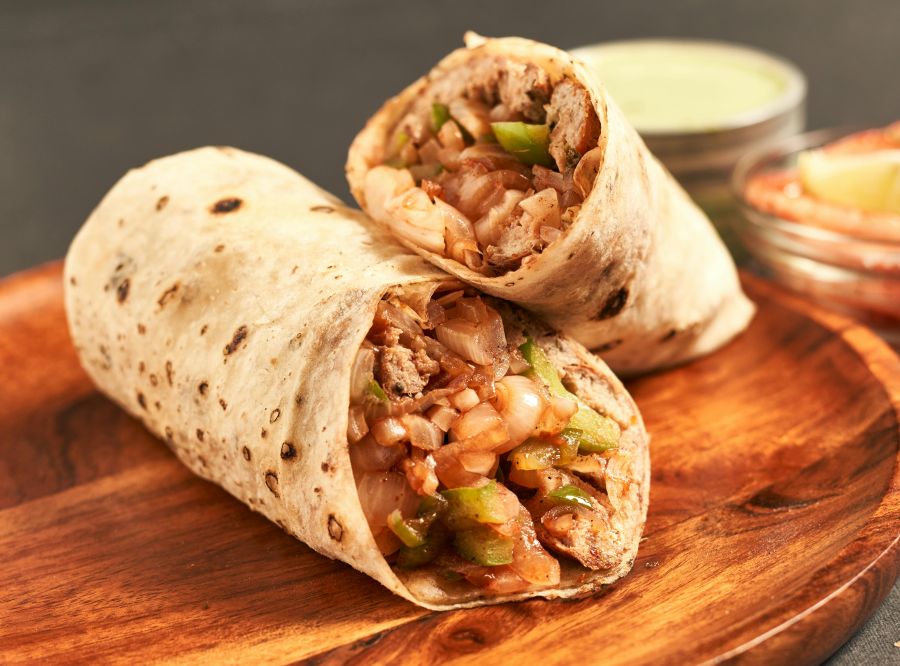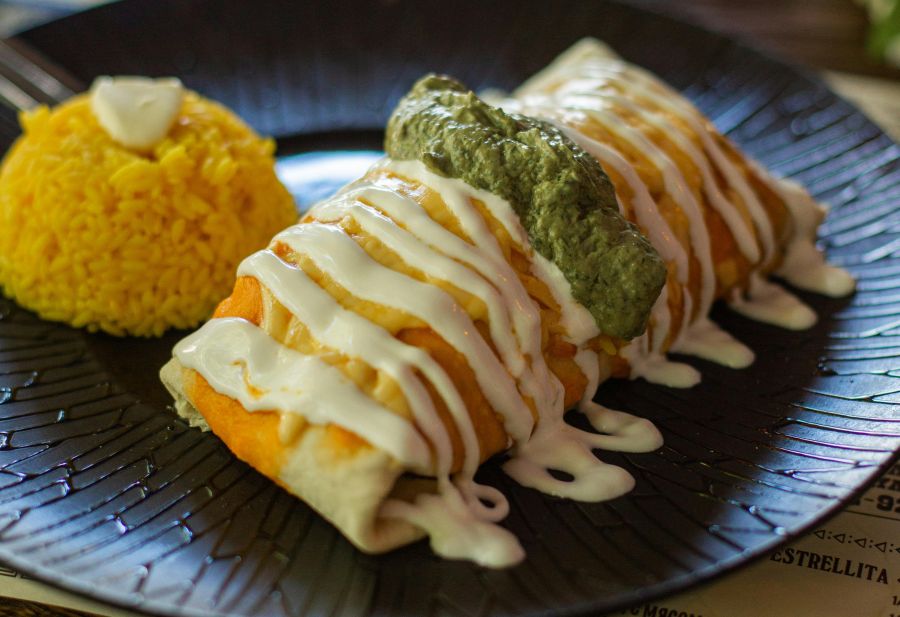Chimichanga vs Burrito is a comparison where similarities abound, yet a line of distinction is often present. These well-liked foods have their origins in Tex-Mex cuisine, which represents a fusion of Texan and Mexican culinary traditions.
And it’s a delicious fusion that has given us amazing foods and flavors. Of course, that includes the heart of our discussion, chimichangas, burritos, and the differences between them!
The biggest difference between chimichangas and burritos usually comes down to frying. Chimichangas are fried, while burritos aren’t. Some even say that chimichangas are fried burritos. Yet, in conventional scenarios, there are more differences, including the fillings and serving style.
Let’s see how it all works out.
Table of Contents
Difference Between Burritos And Chimichanga – The Key Points
Let’s look at the essentials of a chimichanga and burrito comparison with these major points.
Frying – Chimichanga VS Burrito
Chimichangas are always deep fried. Burrito and chimichanga are both tortilla-based foods, which means both are wrapped in a tortilla. For Tex-Mex cuisine, this is a flour tortilla.
When preparing chimichangas, deep frying is the signature presentation. The frying gives the tortilla a unique texture and taste.
As a side note, there is quite some skill involved in frying a chimichanga. As it hits the oil, the tortilla and the filling heat up quickly. As one would guess, the vapor from the moist filling wants to escape and it needs to be managed skillfully. After all, you don’t want the filling for the chimichanga end up in the oil and all you’d be left with is a deep-fried tortilla!
Frying gives the chimichanga a crunchy and oily exterior. This also means that the chimichanga is often served with sauces that make the best of its fried exterior.
Fillings And How They Differ Between Burritos And Chimichangas

In a simplified sense, it is often said that the fillings that go into a burrito are served as sides for a chimichanga.
Quite a variety of materials can go into fillings for burritos. This includes beans, rice, meat, cheese, and a lot more. Technically, your preference for flavor and taste are the limit here. If there’s a food you could wrap in a tortilla, there’s a good chance it can go into your burrito.
There’s also room for vegetables, eggs, and even guacamole or salsa. Basically, most taste buds and diet preferences can be accommodated by burritos.
Chimichangas are different in this sense. The filling is usually meat with little to no sauce or liquid. Things generally served cool like guacamole or salsa are generally served as sides, rather than being added to the filling. Similarly, rice and beans are sides for the chimichanga, not the filling. Any cheese or cheese sauce is also a side for the chimichanga and not a part of the filling.
In a way, fillings for chimichanga also depend on the ingredient’s behavior in frying and handling heat. Ingredients that don’t handle frying all that well can be served as sides, as is the case with beans, cheese, and others.
Serving Styles For Chimichanga And Burrito

This isn’t an essential distinction, but usually, there is a difference between how a burrito and chimichanga are served.
A burrito can be wrapped and packed. So, you could hold it in your hands and take a bite off the burrito even as you walk around. Perhaps add some sauce on the burrito as you take a bite. Of course, there is always room to serve it nicely on a plate, with a healthy serving of sauces, salsa, sides, and more.
A chimichanga generally needs a more conventional serving style. It’s served on a plate, often topped with sauces and other condiments, along with sides like rice, beans, cheese, and more.
Notes On Other Styles For Chimichanga And Burrito
The comparison I’ve listed here presents the differences between burrito and chimichanga that are usually accepted in the culinary world. But these are not absolute and there is no culinary police that’s going around arbitrarily enforcing naming conventions.
As such, several recipes blur the already near-invisible line that puts a distinction on burritos vs chimichanga. While It’s impossible to go through every possibility, here are a few variations worth a note.
- Dry Chimichanga: The dry chimichanga is a classic (fried) chimichanga that’s served without any liquid condiments or dips. So, no sauce or melted cheese for this one. Some might keep it simple and even skip side dishes.
In some sense, commercial products like frozen chimichangas/chimis could also fall into this category, since they are often presented without a sauce. Obviously, it’s the user’s choice whether to keep them dry or to add sauces for flavor. - Wet Chimichanga: This is the more conventional chimichanga. Fried, and served with a good helping of sauces, sides, and cheese.
- Fried Burrito: As we know, a fried burrito is a chimichanga! However, the term “fried burrito” is still sometimes used, mostly in informal settings.
I’m not exactly sure how this term came to be, but it appears several people remember fried burrito as a school lunch in the ‘80s. Apparently, some schools in states like California, Arizona (and perhaps others) had these factory-produced chimichangas as school lunches, and these were presented as fried burritos.
While I haven’t had the pleasure to enjoy these in a school lunch, my (admittedly, not extensive) online research shows that most people who enjoyed this lunch think fondly of it! - Soft Chimichanga: If the world has fried burritos, it also has soft chimichanga! This term represents a chimichanga that has not been fried, or at best, has only been lightly fried. Conventionally, the world knows this food as a burrito!
- Commercial, Frozen Burrito or Chimichanga/Chimis: The usual distinctions we see between chimichanga and burrito often fade away when commercial i.e. factory-produced products come into play. You can have instances where chimichangas have a good filling of cheese, rice, beans – much like a burrito.
In some sense, this is where the “fried burrito” terminology originated from, as already discussed. However, most brands do seem to use some sort of frying for chimis/chimichangas.
And while frozen food has picked up a bad reputation over the years, I would still say that the chimis are quite filling, cost-effective, and delicious! Some well-known products in this category are Jose Ole Chimichanga and El Monterey Chimichangas or Chimis.
How Tex-Mex Is The Chimichanga?
Apparently, I’ve now arrived at the most controversial part of this article! Tex-Mex cuisine represents a fusion of Texas cuisine with Mexican cuisine. In some instances, it’s also a Texas-spin on some Mexican recipes.
Chimichanga usually doesn’t fit this categorization, even though the food is generally categorized as Tex-Mex. As it turns out, Chimichanga may have very well been invented/first cooked in Arizona, and is substantially more popular there, rather than in Texas.
While Arizona is no stranger to Mexican cuisine, or to the fusion of American-Mexican fusion cuisine, some people do find the Tex-Mex label to be a bit odd. However, it is worth remembering that cuisine classification isn’t absolute and that TexMex is considered a subset of the broader Southwestern cuisine (of the United States).
Burrito VS Chimichanga – Settling The Scores
After this discussion on Chimichanga vs burrito, I think it is fair to say that while these famous foods show many similarities, they are also different in meaningful ways. The biggest difference is that chimichangas are fried, while burritos are not.
While there might also be differences based on texture, fillings, and sides served with the dish, it is frying that sets the two apart in a distinct way.
Yet, there can be several variations, especially in popular nomenclature. These include terms like “fried burrito,” which is better referred to as a chimichanga. Similarly, some establishments might offer patrons a “soft chimichanga,” which is a non-fried product, and would perhaps be better referred to as a burrito!

